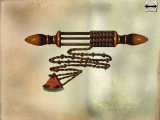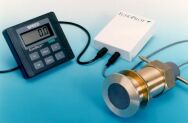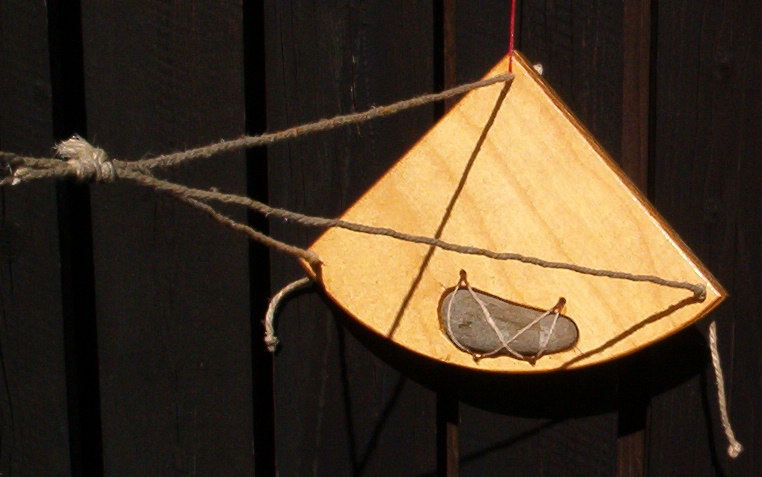The Log
"Heaving the log" is a way to measure a ship's progress
through the water that dates back from the Age of Sail, and was well used
into the 20th. century. Heaving the log was performed many times each day
- typically each half hour - to record the sailed track.
Eventually heaving the log involved dropping a small wood
panel - the "log" - into the water and measuring the length of a line
it pulled off a reel in a given period of time. Time was measured with a
special sand glass. The result is the speed of the ship through the water.
The log itself consists of a flat piece of thin board,
of a quarter-circle, loaded on the circular side, with lead sufficient to
make it swim upright in the water. Fastened to this log is a line of about
300 meters long, called log-line, which is wound on a reel.
 |
The log was cast off the stern of the
ship on the lee side and the log-line allowed to pull out as the log floated
stationary in the water. The line had a series of marks or knots every 14.4
meters (48 feet). When the first knot had unreeled, the sand glass was turned
which ran for 28 seconds. Then the number of knots in the log-line that were
unreeled in this 28 seconds period was counted.
The distance between the marks on the log-line was such that if the ship
was doing one mile per hour, exactly one mark unreeled after the starting
mark. Generally every two-tenths of a knot was extra marked by a colored
rag to do more a accurate estimation of speed.
|
During the course of the history of sailors terminology,
the number of knots that unreeled while heaving the log, became a term
for the speed of the vessel. On a ship doing 5 nautical miles per hour, 5
knots would be unreeled while heaving the log and sailors would simply say
the vessel was doing "5 knots" when referring to the speed of the vessel.
Using a set of "traverse tables" for each half-hour, the ships net change
in latitude and longitude could be calculated from the measured speed. The
calculated half-hour position changes were then summarized and entered into
the ships main record book to determine the net change over the day.
The ships main record book containing information about the ships speed, is
still known as "logbook".
The log was generally used in connection with a sand glass,
and the distances between the knots on the log-line must be figured such
that the "length of a knot" on the line has the same proportion to the nautical
mile as the time of the sand glass has to one hour. For a 28 seconds sand
glass:
( "length-of-a-knot" / 1nm ) = ( 28 s / 3600 s )
yielding 14.4 meters for the "length of a knot" on
the log-line. The total length of the log line depends on the maximum estimated
speed of the ship. For a maximum speed of 10 kn the log line will have a
total length of about 200 meters.
Although commonly used, the origin of the 28 second glass, a rather unusual
length of time, is unclear.
The electronic Log
Today's sailing yachts are equipped with a simple impeller
log, which consists of a device in the form of a small paddle wheel installed
under water just outside the hull on the bow side of the ship. The paddle
wheel (or impeller) carries a small magnet, which by it's rotation induces
electrical impulses in the electronic sensor of the log. The electrical output
of the sensor is directly proportional to the rotation speed of the impeller.
In this way a continuous measuring of the speed of the
vessel through the water is possible. Integrating the instantaneous speed
over time, yields the travelled distance. This calculation is done by the
electronic devices of the log. Both speed and travelled distance - called
"trip" - can be visualized on an electronic display.
The advantage of the electronic log over the traditional
log is that it is more comfortable to use and that it allows continuous monitoring
of speed and trip. However, the outboard impeller of the electronic log is
prone to malfunction due to seaweed or small mussels sticking to the paddle
wheel and obstructing it's free rotate. Also in rough seas, the impeller
may be partly uncovered and yield wrong speed and trip information.
The traditional log, which is more accurate when handled carefully, may well
be used to calibrate and verify it's electronic counterpart.
Acoustic Log
One great disadvantage of the usual paddle wheel transducer
is the need to make a hole in the hull, which may have some implications
to safety and to hull integrity. Also the outboard moving parts of the paddle
wheel are prone to fouling, wear and mechanical obstruction.
 |
The acoustic log has none of these problems.
It is based on Doppler effect and consists of a low-energy ultrasonic transducer
and a signal processor. The transducer is bonded at underwater-level inside
the hull with hard epoxy requiring no holes in the fibreglass hull.
The acoustic signal transmitted by the transducer travelling through
the fibreglass hull is partly reflected in the water outside the hull.
The acoustic echoes from the water particles outside the hull are captured
by the transducer and from this echo information the speed of the vessel
trough the water can be calculated. This calculation and the visualization
of speed and trip information on a display is done by the signal processor.
The acoustic log is able to detect speeds of 0.1 knots up to 50
knots with an accuracy of (+/-1%).
|
GPS
Also satellite-based navigation systems, providing
absolute positions in small time intervals can be used to obtain speed information.
Usually this "speed log" feature is already incorporated in the navigation
software of the GPS receiver.
Construction of a traditional Log
A traditional log has three principal parts:
- the log,
- the log line and
- the reel, which holds the log line.
The log itself can be constructed from a
piece of wood (multiplex board) in the form of a quarter circle. The straight
side will be in a range of 15 to 30 centimetres long. The wood can be treated
with some coating to protect it from the water. On the rounded side, a weight
(e.g. a small stone or some pebbles) must be attached, such that the log
will swim upright in the water.
 |
|
The log will be attached to the log line
by a three-part bridle attached to the three corners of the log. The bridle
line must be adjusted so that the log line pulls exactly perpendicular to
the log. If not, the log may slip to the side or even straight down, making
speed measurements impossible and risking loss of the log.
For easier hauling back of the log, the two lower lines of the bridle
are clamped in their attachment by wooden pegs. If the log line is now suddenly
stopped at the end of the measurement, the clamping pegs will be pulled out
of the holes freeing the lower bridle lines.
|
The log will now lie flat on the water and can be
easily hauled aboard. The pegs can be attached with
thin lines to the log or to the log line so they are not lost.
The thin red line attached at the top corner of the log
in the picture above, is used for sinking the log into the water. This is
especially useful when the log is operated by a single person on a boat with
a respectable freeboard.
Any strong line will do for the log line. Nylon
of the proper size is commonly available but it will stretch a bit, so Dracon
or some other low-stretching line would be better. The effect of stretching
is not so large when the line can unreel freely. However, if the log line
is stopped after the logging interval it will be stretched considerably. Therefore,
the log line reading point, should not be too far away from the reel.
Mark the starting point at a length of about 15 meters
with a red-coloured knot. Some coloured twine knotted on the log line can
be used to mark the knots. The distance between the "knot"-knots depends
on the logging interval
"length-of-a-knot" [m] = "logging-interval" [s] * 0.514 [m/s]
e.g. for a logging interval of 30 seconds, the distance between the "knot"-knots
is 15.4 meters.
The reel holding the unreeled log line should
have some kind of handle connected to the axle. The reel should be able to
spin freely, so that the log line can unreel without straining the line,
to prevent stretching.
If available, the spindle of a fishing rod may be a good implementation of
the reel including the winding mechanism to recover the log line. Otherwise
a plastic spool as used by wire manufacturers may be used with a simple wooden
shaft serving as axle and handles. A knob on the reel rim is essential for
winding in the released log line.
The back end of the log line should be tied to the reel to prevent losing the
log if the line is not held after the logging interval.
Here are some other precautions and tips:
when releasing hundreds of meters of log line, watch out for other
shipping behind you; use gloves to handle the log line. Don't let the log line run through
your hands without protection: it's going fast and will burn. At five knots
the log line is going out at a rate of 2.5 meters per second! three people can be involved in heaving the log: one to hold the reel,
another to bring out the log (carefully not tangling the bridle), count the
knots and manage the line and one to watch the time (count down the time). if operated by one person, the reel can be connected to the stern
realing with appropriate length of advancing log line, such that after sinking
the log into the water, the chronometer can started conformable. the key of making accurate speed measurements using the log, is starting
the time exactly when the "start knot" leaves the reel and stopping the line
exactly on the instant time runs out.
Alternative Log Construction
The calculation for speed can also be done in a reversed
way: measure the time to travel a fixed distance instead of measuring the
distance for a fixed amount of time.
In this case the log line will have only a start knot
and an end knot a distance "log-length" apart. The time to unreel the "log-length"
is measured with a chronometer. The speed of the ship is then calculated
from "log-length" and the "chronometer-time":
speed [kn] = "log-length" [m] / "chronometer-time" [s] * 1.944 [kn*s/m]
The log line is not only simpler, it can also have
a shorter length depending on how accurate the "chronometer-time" can be
measured. A good choice for the length of the log line between the start
and end knots would be 51.44 meters. The calculation then simplifies to:
speed [kn] = 100 [kn*s] / "chronometer-time" [s]
This length of 51.44 meters can be used with good precision
up to 10 kn of speed, corresponding to a "chronometer-time" of 10 seconds,
which can still be measured accurately enough with a simple chronometer.
Again the key to accurate speed measurements is to start the chronometer exactly
when the start knot leaves the reel and to stop the chronometer exactly on
the instant the end knot leaves the reel. An appropriate guidance for the
log line and "pre-marker" to "announce" the start and end knots may be included
to simplify this timing.
Sources:
| 

